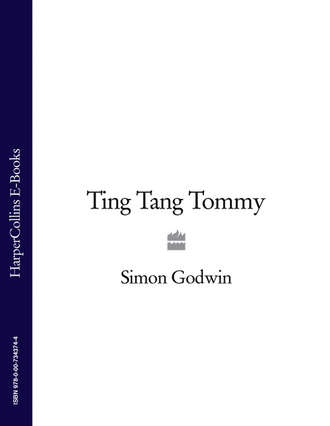
Полная версия
Ting Tang Tommy

Ting Tang Tommy
88 All-Time Great Games
Simon Godwin

For Mum and Dad
‘Why’, said the Dodo, ‘the best way to explain it is to do it.’
Lewis Carroll
Table of Contents
Cover Page
Title Page
Dedication
Epigraph
Introduction
The Original and Best Games for a Party
Word Games for Witty People
Games for the Great Outdoors
Everything you Need for a Rainy Day
Games for a Long Journey
Seasonal Specials
Three Games of Murder and Mayhem
Going Home Bag
Epilogue
Acknowledgements
Bibliography
Copyright
About the Publisher
Introduction
Good games are like good jokes: they get remembered and passed on from person to person. But sometimes they get forgotten. This book is about remembering the best games we’ve ever known. Games are good for our souls. They are magic recipes for cooking up a good time. Once you know the rules you can bring any situation to life. People crave contact. People crave jollity. People crave games.
This book sets out to prove that you can play games anywhere—on the beach, having dinner with friends, at a barbecue, with your family at Christmas. It’s designed to equip you with loads of simple, memorable games that you can share at any moment of the day.
The Games Renaissance starts here.
Games and Me
I’ve been obsessed with games since I was ten, when I started a club with other kids living nearby. Our club was about one thing only: playing games. We had go-kart races, water fights and football matches that lasted long into the night. We built rafts that we sailed down the local river, sold junk on the street and played wide games in the local park, which was a grassed-over quarry with steep sides called the Brickie. It was a wild time of dusky evenings, confusing crushes and grazed knees. Throughout, being the bossy eldest of four, I got a taste for being in charge and a feeling for what makes the best games great.
As a teenager, I wanted to be an actor so, every Saturday morning, I commuted from St Albans to a drama school in Islington where I learnt ‘acting’ games. These were different from the Boy’s Own world of the Club. They were less about heroism and dousing your enemy with a water bomb and more about being spontaneous and inventive. These games encouraged creativity and collaboration. After each class I would practically run back to the station, flushed with hope and exhilaration. I was discovering how the theatre was another version of the Club. As a student I discovered the work of Théâtre de Complicité and saw how they used games to create imaginative and breathtaking works of theatre. Games were a force in their own right. After leaving university I became a theatre director and have been researching and playing games ever since.
A few years ago I started to share the games I had learnt with my friends and family. I discovered they were infectious. At the same time I began asking people to teach me gam es they knew. I slowly began to amass a collection and the result is this book.
My project is simple: to get grown-ups playing games.
Now, more than ever, we are looking for things to do that are active, communal and affordable: camping, ballroom dancing, knitting, home baking, wild swimming and roller discos are all on the up. People are searching for activities that are easy on the environment, big on fun and which have a whiff of nostalgia for a lost golden age. Games answer this need.
Most of the games in this book are short—fifteen, twenty minutes, half an hour. Played with large numbers of people they can take longer, but my aim is to show that games don’t need to be an ordeal. They can come from nowhere and can be played spontaneously with minimum preparation.
All the games in the book have been tested and many are prefaced with an account of how I came to know them, as well as things to watch out for when playing them and occasional references to their historical origin. There are hundreds, even thousands, of games in the world. There are many that I’ve been forced to leave out. The games that have made it into this book are in the Rolls-Royce category; they are games that I have played and that I know really work.
Where Do Games Come From?
Games are deeply lodged in our culture and history. They have always reflected the beliefs, fears and hopes of an age. Knucklebones grew out of the fortune-teller’s bag of tricks and hopscotch is a distant relation of forgotten legends describing labyrinths and mazes. The earliest record we have of game playing

can be found in the ancient palace of Medinet Haboo, at Thebes, in Upper Egypt. Here there is a wall painting showing Rameses III playing a board game with the goddess Isis, wife of Osiris, Lord of the Dead.
The word for play itself has enjoyed a variety of meanings across different cultures. Plato believed that the origin of play lay in the need of all young creatures to ‘leap’. Kridati is a Sanskrit word that means the play of animals, children and adults, but also refers to the movement of the wind or the waves. Our word for play comes from the Anglo-Saxon plega, which means to move fast, to grasp another’s hands, to clap and to play an instrument. The Indo-European root of game, ghem, means to ‘leap joyfully, to spring’ and was used originally to describe the movement of animals as well as people.

Ghem morphed as it was filtered through different European languages. In Old French it became jambe and in Italian it became gamba. Gradually, words developed that referred to people having fun in groups, such as jamboree and camp and campus. In German the word became gaman, in Hellenic it became kampe and in Old Norse it became gems, which meant ‘to come together and congregate as whales do’.
There is something ancient here conveying a sense of people coming together to generate a tribal happiness. This book reflects these visceral origins of playing by including games that are fast, furious and physical. The outdoor games in Chapter 3 revel in ancient ideas of the hunter and the hunted and the power and thrill of running in the landscape. Playing them today gives you a feeling of being part of a tradition that stretches back thousands of years. In Chapter 6 I describe games that have traditionally been played at particular times of the year. These games also stretch back centuries and combine fun with traces of lost rituals.
Many of the games in this book, however, were first written and collected into anthologies by the Victorians. Although many of these had been played for centuries, the Victorians were the first to make an industry out of them. They developed and invented a huge quantity of new games. During the nineteenth century a vast number of games books were published and games became a national obsession.
Why Was This?
Throughout the nineteenth century in Great Britain there was a mass migration to cities. Between 1841 and 1891 the population of London increased from two million to nearly four and a half million. In Scotland there was a comparable surge in Glasgow. The rise in industry and the increase in urban growth led to the formation of a new middle class. These people had left the old, established practices of rural areas to live and work in the city. The days of fairs, bullock running, pigeon flying, cock fighting and village wakes were over. These new communities needed new ways of having fun. They needed games.
And during the same century the new middle class fought for their rights. They achieved shorter working hours, longer holidays and better pay. These innovations, combined with better transport and communication links, freed up time for people to have fun. In the northern cities men joined brass bands; choral singing caught on in the Welsh valleys and pantomimes and music halls started to grip the public imagination. Whist drives, reading groups, picnics, circuses, billiard halls and working men’s clubs gained popularity as a new kind of organized fun took hold.
As well as going out and taking part in group activities, people wanted to make their own fun at home. And this appetite was fed by a radical change that was happening inside people’s homes: the birth of gas lighting. In our bright, modern homes it’s hard for us to imagine what life would have been like by candlelight. If you try counting the lights in the room where you are reading this, I estimate that you will find at least four or five, not including the ambient light that pours in through and around your curtains. At the beginning of the nineteenth century homes were still lit by candles, which were both expensive and of limited strength. Samuel Pepys had to give up writing his diary at only thirty-six because he was worried about going blind—‘and so to bed, being weary, sleepy, and my eyes begin to fail me, looking so long by candlelight upon white paper’—he wrote in 1663. In the centuries of darkness games were things to be played outdoors while inside people told stories, sang songs and played instruments. Pleasure came from the things you imagined rather than saw.
The social historian Dorothy Flanders gives a detailed account of the development of domestic gas lighting in her book The Victorian House. She explains how Friedrich Albert Winsor became one of the first popular exponents of gas lighting in the home, through a series of public lectures and brochures. In 1814 Winsor founded a company with a single gasometer. By 1852 there were forty-seven gasometers in Britain and a network of gas piping, stretching over two hundred miles. The craze for gas lighting spread fast. By 1816 gas was common in London and by 1823 fifty-three cities had gas companies. By the middle of the century, it had become a presence in most small towns and even in some villages. The contemporary journalist G. A. Sala provides a vivid insight into the difference it made to everyday life:
In broad long streets where the vista of lamps stretches far away into almost endless perspective; in courts and alleys, dark by day but lighted up by this incorruptible tell-tale; on the bridges; in the deserted parks; on wharfs and quays; in dreary suburban roads; in the halls of public buildings; in the windows of late-hour-keeping houses and offices, there is my gas—bright, silent, secret. Gas to teach me; gas to counsel me; gas to guide my footsteps.
As well as illuminating streets, gas changed how rooms were lit. The Argand Lamp became a popular innovation in middle-class homes. In stark contrast to the uneven light of candles, the Argand Lamp burned gas at a higher temperature, which created a purer flame. This new, brighter flame was also contained for the first time in a glass cylinder, which saved it from draughts and allowed the flame to be raised or lowered, rather like the modern dimmer switch. Brightness could now be controlled and modulated at will. It was also possible for gas to be run through pipes and tubes to special fittings in the ceilings and walls, even to tables. Wall sockets had flexible attachment points so that lights could be directed towards particular people or objects. The arrival of gas lighting meant that everyone—not just the rich—could now play games long into the night.
And so, for the Victorians, the stage was set for a games revolution to take hold. Is it time for us to discover once again the easy pleasure and communal happiness that only games can offer?
The Original and Best Games for a Party
I want to show you how games can be played anywhere. But parties are the place where most of us get our first taste, so let’s start there. When I say party I am thinking of a group of adults or a family gathering with a good spread of ages. There have been lots of books on children’s party games so that’s not my remit here. I want to share forgotten but universal games that can be played by all.
At a party, timing is important. You have to wait for a lull. You have to wait until the group wants something new. And not everyone may want to play. This is fine. You are looking for a majority. If you can get most people onboard, a game is possible. Never force people to play. They can either just watch or you can give them special roles—like being the referee, timer or scorer. Everyone likes to feel included.
Arriving
Games that welcome people are fun. You might have a large jar of sweets near the door and get people to write down what they think is the correct number on a sheet of paper nearby. It’s nice to have something to announce later in the evening and even nicer for the person who gets to walk away with the jar of sweets. Another good icebreaker is to ask everyone to bring a photograph of themselves as babies. As people are helping themselves to a glass of wine, you can fix each photograph to a piece of cardboard with a number under each one. On pieces of paper against the numbers, people can write down who they think is who. It’s a great moment at midnight, or towards the end of the night, to bring in the photo board and to ask each grown-up baby to step forward one by one. You can award a prize to the winner but the fun comes from seeing how the babies in the photographs express the intangible essence of the grown-ups they become, something which never quite leaves them.
Mister Hit
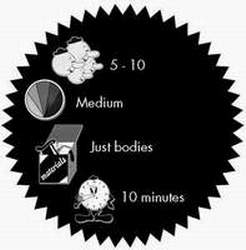
Everyone stands in a circle. Someone is nominated as Mister Hit. Their job is to tap the person standing to their left or right, preferably on the shoulder. The person tapped must say someone else’s name in the circle. This person then becomes Mister Hit and must, in turn, tap someone else to their left or right. So the basics are: when you are hit you call someone’s name and when your name is called you hit someone.
After a few practice rounds the game becomes fun as you explain that there will now be no hesitation between hitting and speaking. There must be an unbroken chain of hits and names. Don’t be afraid to be harsh. As soon as someone hesitates, or speaks when they should hit or hits when they should speak, they are eliminated.
You carry on playing until three remain for a Mister Hit final, after which the two last players are declared the winners.
Lie Detector

Each player shares three things about themselves. Two of these must be true. One must be false. In the spirit of Radio Four’s The Moral Maze, everyone in the group is given the chance to interrogate the speaker. The group grills the speaker to discover how well they can back up their claims. You can limit the number of questions each person is allowed to ask if the group is big. When everyone has had the chance to ask their questions, the group decides together which statement they believe to be the false one. This is the most fun part as everyone struggles to reach a consensus. When a majority decision has been reached, you announce your verdict and discover whether you’ve successfully deciphered fact from fiction. Watch out for hesitation, faintly concealed smiles and discreet blushing.
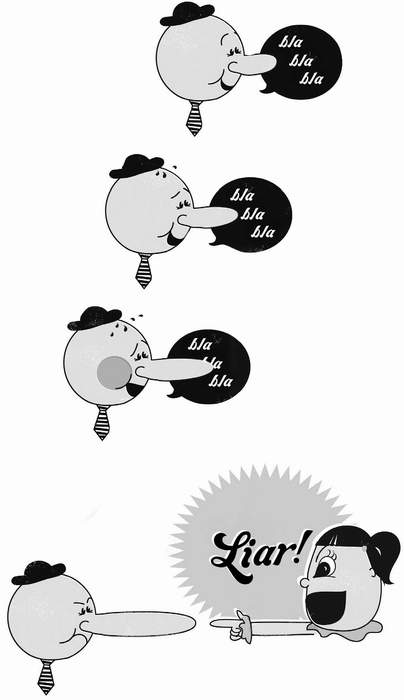
Blind Man’s Buff
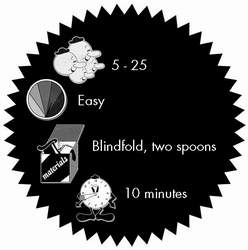
Hot Cockles is a violent game with a rich tradition. It belonged to what the Greeks called the kolla bismos family of games: ‘buffeting’ games. A player is blindfolded and then struck by each player in turn. The blindfolded player had to guess the identity of his assailants by the quality of their slap.
The game also contained the potential for romance. It seems that the fun lay in decoding the hidden suggestions within the blow. In a Christmas edition of the Spectator from 1711, a joke correspondent wrote: ‘I am a Footman in a great family and am in love with the House Maid. We were all at Hot Cockles last night in the Hall; when I lay down and was blinded, she pulled off her shoe and hit me with the Head such a Rap, as almost broke My Head to Pieces. Pray, Sir, was this Love or Spite?’
Alongside Hot Cockles there developed the variation we all know, Blind Man’s Buff. This game proved too rowdy for Samuel Pepys. On 26 December 1664 he wrote in his diary, ‘I to bed, leaving them to their sport and Blind Man’s Buff.’ We later discover that the party continued until 4.00 a.m.
Today there are loads of variations but the version I prefer is a silent one. Any game that encourages the gentle crossing of boundaries is supercharged with fun and danger. Just taking out a blindfold can cause minor hysteria and as soon as an element of touch is introduced people go crazy, especially after a few drinks.
A brave individual is blindfolded. Everyone else takes up their positions—in corners, on chairs, lying on the floor, wherever feels most fun. They must remain there without making a sound. The blindfolded player must identify each player only by touch. As chuckling or giggling gives the game away immediately, it’s very important that everyone keeps silent. The game lasts either until everyone is correctly identified or you can switch after the first person is identified, that person then taking over the blindfold.
A wacky variation is to arm the blindfolded player with two spoons. He then uses these in place of hands. You can just about make out height, hair length, size of nose, breasts or not etc. Here avoiding laughter is impossible: the feeling of two cold spoons being passed over your face and other parts is quite overwhelming.
General Post
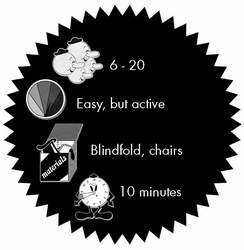
Everyone sits on chairs in a large circle. Someone is appointed Postmaster while everyone else chooses cities in the world. These cities are destinations for the post and the Postmaster must remember them all. It will be his job to call out the origins and destinations of the mail. At the start, one player is blindfolded and placed in the middle of the circle. The game begins when the Postmaster calls out the first journey using the cities around the circle. He might say, ‘The post is going from Berlin to New York’. And so now the person who is Berlin must change places with the person who is New York. They must do this without the blindfolded player either touching them or getting to an empty chair before they do. The player who is touched, or whose chair is taken, must take over the blindfold. To get everyone moving, the Postmaster can occasionally call ‘General Post’, which means that all the players have to change seats, giving the blindfolded player an excellent chance to grab someone or a seat. Play until everyone who wants to has had a go in the middle.
Caterpillar
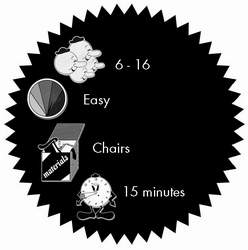
Begin by making a circle of chairs. Everyone sits down apart from one person who remains standing in the centre. His or her chair remains empty. The game revolves around this player’s attempt to sit down on an empty chair while the other players work to stop them. To do this players have continually to move from one chair to another. As soon as one chair has been vacated another bottom must fill it. Players can move from side to side and across the circle. As soon as the centre player manages to occupy a seat, the dislodged player takes over.
Psychiatrist
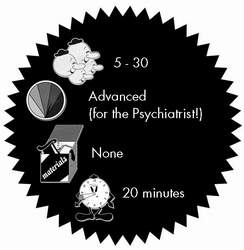
A Psychiatrist is selected from the group. It’s his job to diagnose the condition everyone is suffering from. He leaves the room while the group agrees what condition they might all have. There are unlimited options but the classic ruse is that everyone answers as if they are the person sitting to their left. The Psychiatrist returns to the room and starts to ask questions of his or her patients. How are they? What do they like doing? Do they have any particular fears, dreams etc? People have to answer as accurately as possible according to their knowledge of the person to their left (which itself proves very revealing). When the Psychiatrist is completely baffled you can help him by suggesting he ask each patient their name.




